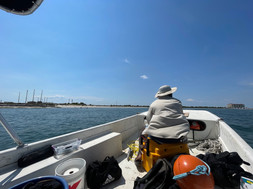Research



Did you know that corals can be found all along the eastern coast of the US, even in the (relatively) chilly waters of North Carolina?
Temperate (cold-water) corals have historically received little attention from the research community, but that's changing rapidly. As climate change continues to threaten tropical coral reefs, scientists have worked to find a suitable model organism to understand the breakdown of the coral-algal symbiosis (bleaching). The temperate coral Oculina arbuscula -- a calcifying, facultatively symbiotic coral abundant in the southeastern US -- has recently emerged as an ideal candidate.
Tropical corals exist in an obligate symbiosis with their algal symbionts, who are members of the dinoflagellate family Symbiodiniaceae (you might know these as "zooxanthellae"). On the other hand, temperate corals are facultatively symbiotic, which means they can exist both with or without their algal symbionts. Colonies can be found with both symbiotic (high symbiont density, brown color) and aposymbiotic (low symbiont density, white color) branches, or as entirely symbiotic or aposymbiotic colonies in the wild. O. arbuscula can also modulate its symbiotic state by transitioning between white and brown, allowing it to acclimatize to changing environmental conditions and making it uniquely suited for investigations of the coral-algal symbiosis.
The goal of my masters thesis is to characterize the microbial and symbiont communities associated with symbiotic and aposymbiotic colonies of O. arbuscula at three distinct sites near Morehead City, NC: Cape Lookout Jetty, Radio Island Jetty, and the Newport River Highrise Bridge. This work will advance O. arbuscula's role as a model by elucidating differences in microbial communities associated with symbiotic and aposymbiotic corals and how these vary across space and time. Come back soon for data and findings!
